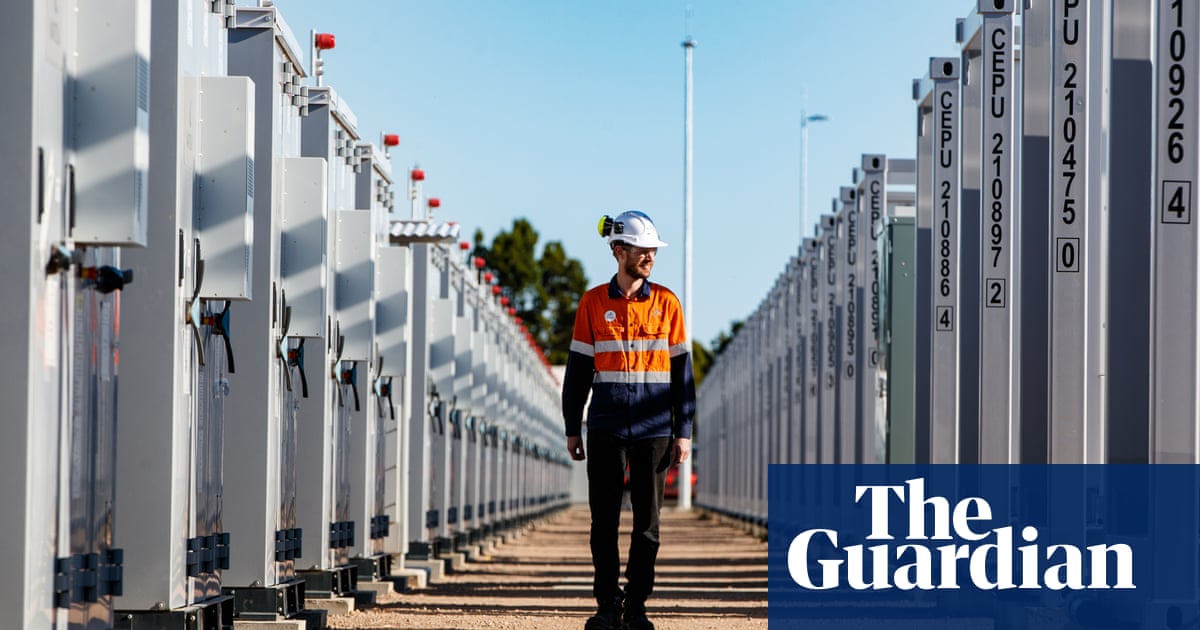Investment in big batteries hit $2.4bn in the first three months of 2025, making it the second strongest quarter for energy storage on record in Australia.
Thelatest datafrom the Clean Energy Council found six new storage projects – totalling 1.5 gigawatts capacity – reached financial close (the financial commitment that means the project is likely to be built) and a level of investment last seen in the final quarter of 2023 with a record $2.8bn.
The largest was the four-hour Wooreen battery system in Victoria, at 350MW, which was supported by the federal government’s capacity investment scheme.
Three large-scale battery systems in South Australia, one in Queensland and one in New South Wales also reached financial close.
Renewable energy had a slower start to the year, with two solar farms – totalling 386MW and $410m investment – reaching financial close. A quieter first quarter was typical, the CEC said, with investment ramping up throughout the year.
Sign up to get climate and environment editor Adam Morton’s Clear Air column as a free newsletter
“Over the past five years, new investment commitments in the first quarter of the year have averaged 427MW, compared to a Q4 average of 1,153MW over the same period,” it said.
By the end of March, 82 renewable energy projects had either reached financial commitment or were under construction, representing 12GW of capacity.
The strong result for storage in the first quarter followed Australia’sbiggest yearfor clean energy investment in 2024, in which rooftop solar installations on homes and businesses raced past 4m, the CEC’sannual snapshotfound.
Investment in large-scale renewable energy hit $9bn, a 500% increase on 2023. This combined with investment in energy storage to deliver the nation’s highest clean energy investment on record at $12.7bn.
The CEC’s chief policy and impact officer, Arron Wood, said political certainty would continue to help drive the “eye-watering” levels of private sector investmentneeded for the government to meet its target of 82% renewable energy by 2030.
“The target is ambitious, but it’s achievable,” Wood said. “With the election behind us, inflation easing and strong industry participation in the Capacity Investment Scheme, the early signs suggest we can expect to see private sector investment in both renewable power generation and battery storage projects continue to increase as the year progresses.”
Renewable energy provided 40% of Australia’s total electricity generation in 2024, up from 39.4% in 2023. The CEC report said an additional 6GW from wind and solar farms would be needed annually by 2030 to replace retiring coal generation.
“The CleanEnergyAustralia report has a lot of really good news in it,” Wood said, adding that it showed investment flowed with the right policy settings and continuity.
“The willingness to build Australia’s energy transition is there. But that’s not something where you can just set and forget.”
Sign up toClear Air Australia
Adam Morton brings you incisive analysis about the politics and impact of the climate crisis
after newsletter promotion
New transmission lineswere critical to maintaining the pace, along with connecting projects to the grid as quickly and efficiently as possible, Wood said. Working with communities to build support for the transitionand maximise local benefits was also important.
The director of Clean Energy Finance, Tim Buckley, said there was cause for optimism but maintaining the pace of investment and developmentrequired much quicker approvals, construction and commissioning.
“We need to get speed and scale way beyond current rates, particularly with extended delays to grid connection,” he said.
“There is great momentum, and more to do,” said Anna Skarbek, the chief executive of Climateworks Centre.
She said the electricity transition was tracking well in terms of replacing fossil fuels with renewable power.
“We know that to achieve a prosperous economy, in a fully decarbonised global economy, when all sectors are net zero – that actually will use a lot more electricity than what we use today,” she said.
Reaching the government’s legislated target of net zero by 2050 would mean at least a doubling in electricity demand as other sectors including transport, mining and industry sought to cut their emissions.
“We know that Australia has the capacity to do that,” Skarbek said. “Australia does have very large-scale potential to use renewable energy in its heavy industry sectors, and that’s a really important contribution to global trade. And also we have world-class solar penetration at what’s considered small scale or distributed energy in households.”
